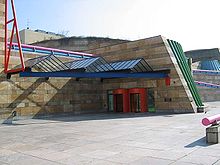|
Staatsgalerie Stuttgart
The Staatsgalerie Stuttgart ([ˈʃtaːts.ɡaləˌʁiː ˈʃtʊtɡaʁt], "State Gallery") is an art museum in Stuttgart, Germany, it opened in 1843. In 1984, the opening of the Neue Staatsgalerie (New State Gallery) designed by James Stirling transformed the once provincial gallery into one of Europe's leading museums. Alte StaatsgalerieOriginally, the classicist building of the Alte Staatsgalerie was also the home of the Royal Art School. The building was built in 1843.[1] After being severely damaged in World War II,[2] it was rebuilt in 1945–1947 and reopened in 1958.[3] It houses the following collections:
Neue Staatsgalerie The Neue Staatsgalerie, a controversial[4] architectural design by James Stirling, opened on March 9, 1984 on a site right next to the old building. It houses a collection of 20th-century modern art — from Pablo Picasso to Oskar Schlemmer, Joan Miró and Joseph Beuys. The building layout bears resemblance to Schinkel's Altes Museum, with a series of connected galleries around three sides of a central rotunda. However, the front of the museum is not as symmetrical as the Altes Museum and the traditional configuration is slanted with the entrance set at an angle.[5] Notable works in collection
In 2013, the Staatsgalerie returned Virgin and Child, a 15th-century painting attributed to the Master of Flémalle (1375–1444), to the estate of Max Stern, a German-born Jewish dealer who fled the Nazis and later operated the Dominion Gallery in Montreal.[6] See alsoReferences
External links |
||||||||||

